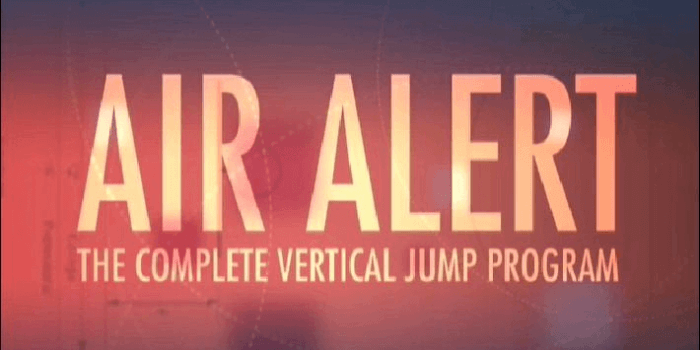
air alert summary review
- Results are really slight, and it does not deliver what's advertised or promised, with high risk of injury.
- Price is very reasonable, yet the product is not digital, which will cause a delay in your training.
- Difficulty is very high due to the intense training of the program.
Over all rating: 1.5 / 5
results
price
difficulty
One of the oldest and most hyped product on the market, and one that most likely pops up whenever you look up vertical jump training is Air Alert in its four series.
That’s right! Not one, not two, but four.
Well, let me save you the extra few clicks and the loads of hard work you’re going to be putting into the training, it is not worth it.
If you’re looking into adding inches to your jump, this isn’t it for you. But stayed tuned till the end as I will provide you with more successful alternatives.
Let’s get right into it…
What is Air Alert?
Air Alert was created and launched in 1991 by Timur Tukel, and was associated with vertical jump training ever since. The program claims to increase your vertical jump by 8 to 14 inches in 15 weeks.
Add to what a great marketing campaign and you have a program that’s the talk of the town.
But does it work? We’ll find out in a bit…
Why Choose Air Alert? (DON’T)
It is one of the first jump training programs on the market. It gained its popularity back in the 90s because it had the perfect plan laid out for athlete who are looking to increase their vertical jump.
There was no other vertical jump training program at the time, therefore it had nothing to compete with and grew popular right away. Athletes and basketball players from all over the world were training using it. Few years after that, vertical jump programs started to show up, by well known Athletes like Jordan Kilganon founder of Bounce Kit and Boingvert by Shawn and Kelly. Unfortunately, they weren't as GOOD as advertised too.

It had one big red flag though. It is not science-based. That’s why I’m making this review. The program is still up for purchase to this day, and I’m here to tell you why you should NOT use it.
Normally, I leave my conclusions on a product till the end, but with this program I want to be transparent and straight forward right from the start.
This program will not do anything for you, and it might cause you serious injuries.
I tested the program from start to finish to give you my honest opinion. For the millionth time, stay away from it as much as you can.
best air alert alternatives
#1
4.6/5
- Increases your vertical 15+ inches
- you can do it anywhere (does not require a gym)
- 8-week period
- easy to understand
- costs $137 ($67 discount link below)

#2
4.2/5
- 12-week period
- needs a gym? (yes and no)
- very detailed
- costs $97
- best fit for two foot jumpers

Why Air Alert Fails to Deliver its Claim
As I mentioned earlier, this whole program is based on the “habitual jump training” concept or what is referred to as “kangaroo effect”. This means that you train your legs on jumping until they generate force and you begin to jump higher.
This makes sense theoretically, but there’s no scientific basis to this.

And I’m sorry for breaking it to you, but this kind of “science” is ineffective. Recent studies in jump training have shown that in order for your jump to improve, you need to push your body to the maximum. Repetition on the same exercise will cause your muscle to adapt to the exercises. Therefore, a one for all program will not show you any progress.
In fact, if anything your vertical will decrease.
That’s not all. The worst and most dangerous thing about the program is that it could lead to serious knee and ankle injuries. A lot of players and athletes who have trained with Air Alert have reported various ligament injuries.
The Air Alert Workout Program
Air Alert is a 15 week-long program that requires to train 3 times a week. The program pretty much is the same throughout the entire period of training, with a slight difference of increasing the repetitions every week.
During the even weeks you workout on Tuesdays, Wednesdays and Thursdays. This means you’ll be training intensely for 3 days straight, which will leave you powerless and most likely in high risk of injury. As you’re the odd weeks, your workouts will be Mondays, Wednesdays and Fridays. This way you’ll be getting a day off between every training day. And you’ll be alternating between even and odd weeks throughout the entire 15 weeks of training.
This approach makes no sense and there is absolutely no logic behind it.
Other than alternating weeks, there isn’t much of a variation in the program. You get weeks 8 and 13 off to recover depending on which edition of the program you’re using.
And let me tell you, if you’re going to build up to 2,500 repetitions by the end of the training program.
Air Alert Exercises
The program is formed of 6 workouts to use your body weight to get results:
1- Leap Ups
The way to perform this exercise is by dropping down to a 1/4 of a squat and then just 10 to 12 inches high without moving your arms. This workout must be repeated until you complete the set.
2- Calf Raises
Stabilize the ball of your foot on stairs and grab onto the rails, or use a footstep and something to maintain your balance. Lower your heel just under the stair rim and elevate your foot as far as you can. You should feel your calves muscles tighten and burn once you repeat the exercises for a certain number of times.
3- Step Ups
You’re going to need something to elevate your foot on (i.e a chair or a stool). You start by placing your foot on a chair, and you use this foot to jump as high as you possibly can. Right when you’re about to land, switch your legs and repeat until you complete the set.
4- Thrust Ups
This is very similar to leap ups, but this time you want be doing a ¼ squat. You curve your legs less and you utilize your arms and calves to help you jump without staying on the ground for too long between your jumps. Therefore, your jumps must be quick.
5- Burnouts
Your legs must be straight, and you should not use your arms. You repeatedly jump at the tips of your toes without your heels touching the ground. Your jumps must be 2 to 3 inches high.
6- Squat Hops
The only equipment you will need for this exercise is a basketball. You start out fully squatted and you grab a basketball, which will help you maintain your balance. Jump as high as you can. Once you land, go back to a squatted position and repeat until you complete the set.
All 6 exercises are designed to make your legs used to jumping until it becomes easy, which will make you jump higher by the time. The exercises only require your bodyweight and no additional equipment or going to the gym. There are, however, the lack of scientific data which show that this is false and Not what you should be doing.
If you ask any professional athletic trainer what to improve your vertical, they’ll all tell you the same formula:
Strength + Quickness= A Higher Jump
Every time you push your body to it’s maximum power by doing workouts such as squats and deadlifts, and you push your body to develop it’s speed between jumps, you gain muscle strength.
These types of workouts require you to normally do 10 to 15 reps, but the body muscles are naturally incapable of performing more than their maximum capacity. So when a program tells you to do a 100 thrusts or 300 of another exercise, know that this is doing almost nothing for your vertical, as your training your muscles to adapt to the workouts rather than training it for powerful jumps.
On top of that, there is nothing special about these workouts. They’re simply a bunch of different plyometric or bodyweight exercises that have been done by athletes for decades. What’s different is that you do them in extremely higher numbers than usual. This is the way to do it when you’re trying to improve your vertical jump.
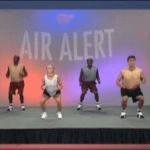
Leap Ups
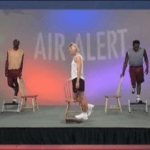
Calf Raises

Step Ups

Thrust Ups
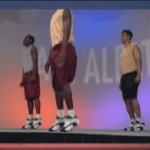
Burn Outs
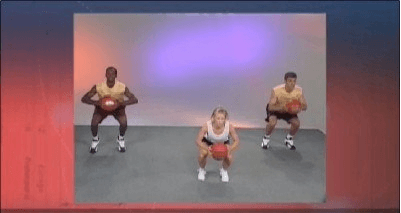
Squat Hops
Pros and Cons Of Air Alert
It is very hard to find any goods in this program considering what it is. Simply outdated and lacks variety. But I’ll try to be as objective as possible.
- Pros
1- Enhances Endurance
I know it’s very strange to mention this considering the high number of exercises and reps, but even if this program does not make a lot of difference in your vertical, it will get you in good shape as it’s a very good cardio program.
- Cons
I could go on and on when it comes to the bad regarding this program, but I will keep it simple with the most important disadvantages.
1- Causes Very Dangerous Knee Injuries
I cannot stress enough how dangerous this program is to athletes of all age groups. Once you purchase the program, there’s no going back. You will be suffering from chronic knee and ankle injuries, leaving with the knees of an 80 year old that you won’t be able to opt for any other program in the future.
2- Very Outdated
The program was first launched in 1991, and since then, the vertical jump training world has witnessed a lot of progress. Air Alert has remained the same through all these advancements in all 4 editions.
In order to improve your vertical jump, you need to push your body into maximum capacity. So the technique of “getting your muscles used to jumping” is simply ineffective. It is possible to reach your goal without completely exhausting yourself.
3- Can’t Be Used During Game Season
Because it is such an intense program with a lot of workload, it’s already given that you’ll be too drained to do anything else other than train, let alone perform any physical activities. Therefore, it is difficult to train and play simultaneously during game season.
4- Does Not Live Up to Expectations
The program provides too many claims and promises that are almost impossible for it to live up to.
The workouts do not make any sense and there no scientific basis to any of the theories it is based on, or the concept behind the workouts and their techniques. It looks like nothing other than a scam or a marketing trick.
5- Not Digital
This follows up to the negative point that the program is so outdated. Most recently launched and successful vertical jump training programs have a membership portal that you can log into to access the workout.
Air Alert is so old to the point that you have to wait for the program to be shipped to you as a DVD and a workout chart to be able to begin using the program. If anything calls for losing motivation, it is being unable to try something as soon as you purchase it.
And what’s even worse is having to wait for something for a long time and it turns out to be terrible. That’s exactly the case with Air Alert.
in a nutshell, Does the program work?
Maybe for beginners who have never done vertical jump training, but it won’t do anything for a professional athlete. You will gain some inches the first few weeks, but after week 4, you will most likely flatten out and no longer make progress because your muscle grew accustomed to the workouts.
Even if you do see results, which will be insignificant to the amount of work you are putting in, you will be severely injuring yourself or putting yourself at the risk of an injury as these workouts are not safe.
Final Thoughts
I think I have made my verdict very clear. Stay away from this program.
Sure, it has been somewhat effective to a few of those who have tried it, but what are 3 or 4 inches when you are training as much as you are.
Air Alert Alternatives:
1- Vert Shock
This has got to be the best and most effective programs in the market. I would recommend it to anyone who’s interested in increasing their vertical in a heartbeat.
The program was created by Adam Folker and incorporates updated and plyometric exercises and techniques that will help you achieve your goal in less than 8 weeks.
The plus point is that not only does it increase your vertical, but it also teaches you how to dunk properly. And the best part? You do not need to hit the gym or use any equipment.
These workouts can be done at home or at the park and they do not take longer than an hour to complete.
It is vouched for by so many athletes that it has helped jump higher, and it doesn’t even cost that much for a program that is this effective.
Check out my review here.
2- The Jump Manual
The best program hands down to train your vertical jump before Vert Shock launched was The Jump Manual.
The program launched in 2007 and completely altered people’s view om vertical jump training.
The best part is that this program covers everything. Every workout, exercise, tip, trick or technique known by the best athletes were all combined into an e-course available to anyone who dreams of a higher jump.
Alternative to Vert Shock, if you love hitting the gym, then you will love this program because it takes persistence and equipment you’ll be using for weight training.
You can check out my The Jump Manual review here.
Conclusion
Air Alert has been in the vertical jump training market for a very long time and is probably one of the most known program names.
Being as popular as it is, you’d expect a lot but unfortunately it disappoints a lot. It’s hands down the oldest and most dangerous program out there.
The vertical jump world has witnessed a lot of advancement in the last few years so really, there’s no excuse as to how terrible this program is. Especially when there are better and more successful programs continuously being launched.
The conclusion is that this program will not be showing results if you are expecting any. If you were to use it, it will leave you too crippled to try out any newer more effective programs.
It’s very disappointing seeing very popular NBA players endorsing such programs. It makes it look like they care about the coin they’re making from advertising these products rather than seeing their following achieve results. It’s very clear now where the popularity of the program came from.
Hey, I’m Aleksandar and I am a Basketball freak! That is why I decided to create this blog. Teaching people How to dunk a basketball and How to Jump Higher in this sport or other related sports that require vertical jumping, is my specialty. If that’s your aim, then you have come to the right place.
